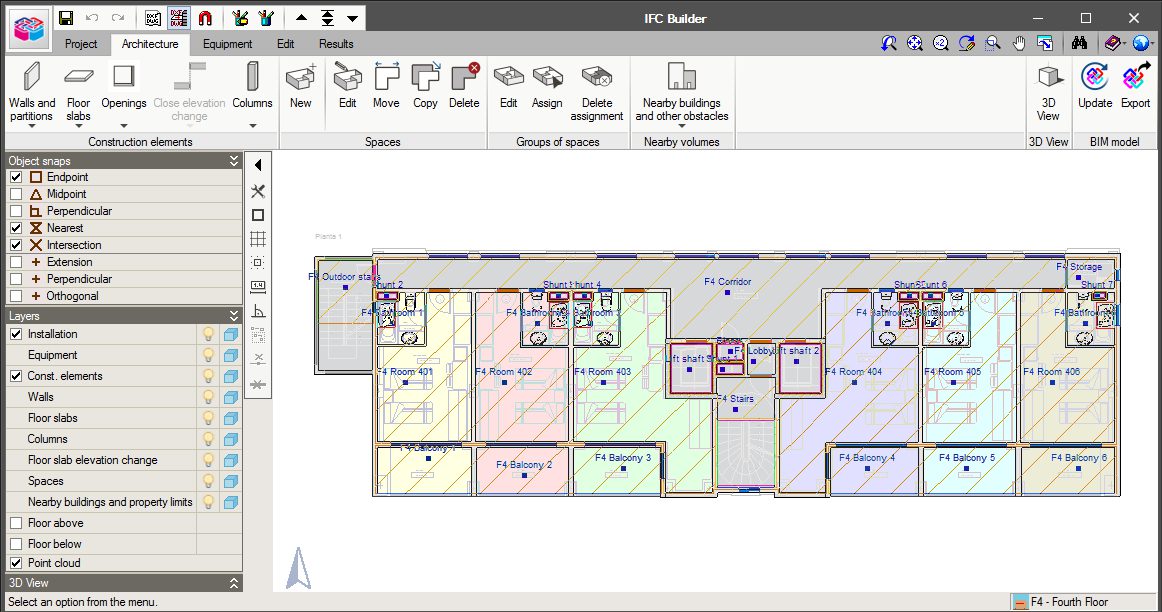What is BIM?
Building Information Modelling (BIM) is the process of constructing a building in a digital virtual environment prior to constructing it physically. This includes integration of the information from the disciplines of Architecture, Structural Engineering, and Mechanical and Electrical Engineering and Public Health (MEP) to produce a single coordinated model of a building.
The implementation of BIM for each project is categorised into three levels, which are summarised as follows:
- BIM Level 1: Use of 3D Computer Aided Design (CAD) for concept work and 2D CAD for output to a common standard, with information shared in a Common Data Environment (CDE), such as an extranet.
- BIM Level 2: Use of 3D CAD for collaborative working i.e. sharing 3D information in a common file format to enable coordination between all parties.
- BIM Level 3: A fully collaborative information exchange with multi-disciplinary input into a single model, ideally under the umbrella of a single collaborative contract.
What can BIM offer?
Implementation of BIM can offer a multitude of benefits from design to operation, including:
- Baseline modelling of existing building
- Coordination of Architecture, Structure and MEP
- Integration of proprietary components
- Testing of design options
- Visualisation of spatial design and appearance
- Output data
Baseline modelling of existing building
To achieve the maximum benefit, the integration of BIM should be at the earliest design stages of a project. With appropriate survey data, a digital 3D model of the existing building can provide a wealth of information, including analysis of the existing building’s performance. This can assist in informing the retrofit design strategy.
Coordination of Architecture, Structure and MEP
Each party will develop their design information locally but can share it in a common 3D model. This enables an iterative process of coordination to take place, including ‘clash detection’, which facilitates the design process and mitigates any risk of problems that might occur during the construction of the physical building.
Integration of proprietary components
It is now common for manufacturers and suppliers to have their own virtual ‘library’ of components, which can be integrated into the BIM model. The components will have specific spatial and performance data embedded, which provides the designer with an additional layer of accuracy when developing the design and can also assist the occupier in understanding the design life and maintenance requirements of each element of their building.
Testing of design options
In addition to mitigating the risk of future coordination issues, a BIM model can be used to test both spatial design and predicted performance of the building. For an intervention on an existing building, this means that the thermal performance, daylighting etc. can be optimised and the most successful design brought forward.
Visualisation of spatial design and appearance
One of the added benefits of construction a virtual 3D model is that it enables the designers to output 3D images of the building, which help clients, Planning Authorities and other stakeholders to visualise the spaces and aesthetic of the completed design. Recently, developments in Virtual and Augmented Reality (VR and AR) have made this process even more immersive and can also be adopted into the construction of the final building.
Output data
During the design and construction process, the benefits of BIM for coordination are numerous, but the inherent data within the model can also be employed for other purposes. This can include output of quantities or component types during the construction process (which can assist in costing the design or creating a robust set of tender documents) and also data for the occupants, such as which manufacturer to contact to replace a window or a prediction of when they need to replace a lightbulb
BIM and RenoZEB
RenoZEB is a strategy of renovating existing buildings via a system of proprietary ‘plug and play’ façade components and a refurbishment of the internal heating, lighting and ventilation infrastructure to convert them into nearly Zero Energy Buildings (nZEB).
The use of BIM is already integrated throughout the RenoZEB process:
- Baseline Modelling
Any existing buildings that undergo the RenoZEB treatment are modelled first to enable us to establish their current performance and target the most efficient and cost-effective areas for improvement.
- Coordination
As a refurbishment strategy, the challenges of coordination are different from those of a new build. The structure remains as existing, so the primary concerns are the configuration of the modular cladding and the integration of any new services internally. Using BIM enables the RenoZEB team to coordinate the cladding, fenestration and service routes with the existing layout.
- Design Integration
The RenoZEB façade comprises a series of modular panels, which are interchangeable BIM objects, enabling us to explore the various design options quickly and efficiently and the extent to which the Building Integrated Photovoltaics (BIPV) are implemented. The output of these designs are shared with our clients via a web-based viewer, to facilitate their involvement in the process.
- Output Data
Ultimately, the goal of RenoZEB is to transform underperforming buildings into net-Zero Energy Building’s (nZEBs), benefitting both the occupants and the environment. As is demonstrated by our Case Studies, use of Energy Modelling as part of the BIM process has predicted reductions of 60% in energy use.
In Conclusion
Employing BIM ensures that our RenoZEB projects are fully coordinated, visually appealing and high performing and provides an element of cost-certainty, by enabling us to explore design options in detail.
Throughout the process, the developments are communicated in a way that makes it straightforward and accessible for our clients to understand and visualise. Why not learn more about the role of BIM in the RenoZEB project here.
[this post was authored by James Leminis of EP Projects]


